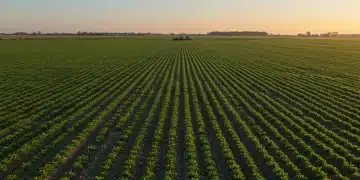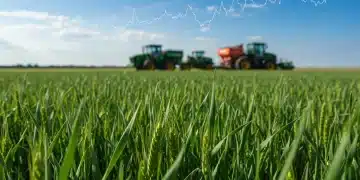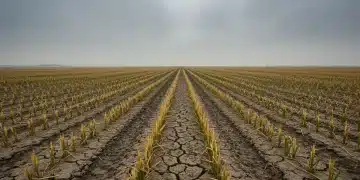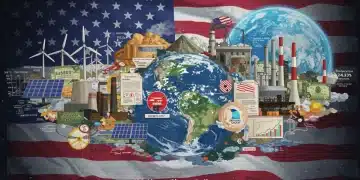Sustainable Agriculture Tech: 25% Water Use Reduction by 2025
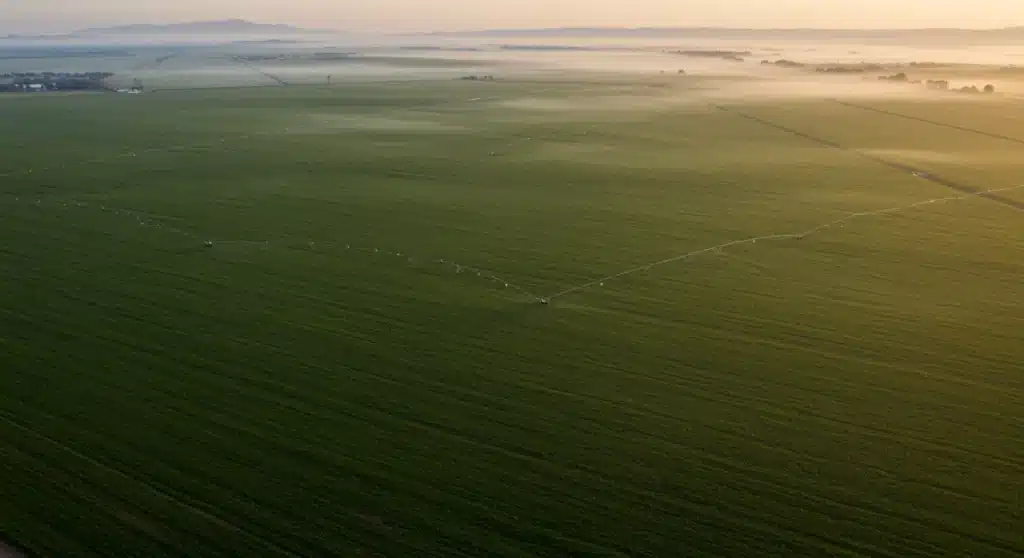
New advancements in sustainable agriculture technology are set to achieve a 25% reduction in water usage across U.S. farms by 2025, marking a significant step towards environmental sustainability and operational efficiency.
Recent developments indicate that significant strides in sustainable agriculture tech are
on track to reduce water usage on U.S. farms by an ambitious 25% by the year 2025.
This critical goal is being driven by a confluence of innovative technologies and farming practices,
promising a more resilient and environmentally friendly agricultural sector.
What does this mean for the future of farming and our precious water resources?
The Urgent Need for Water Conservation in U.S. Agriculture
The agricultural sector in the United States accounts for approximately 80% of the nation’s consumptive water use,
making it a primary target for conservation efforts. As climate change exacerbates drought conditions and groundwater
depletion, the urgency to optimize water usage on farms has never been greater. This push is not only environmental
but also economic, as water scarcity directly impacts crop yields and operational costs for farmers.
Federal agencies and private industry stakeholders are increasingly investing in research and development to address this challenge.
The goal of a 25% reduction by 2025 reflects a concerted effort to implement scalable solutions across diverse agricultural landscapes,
from the vast cornfields of the Midwest to the specialized crop regions of California.
Precision Irrigation Systems: A Game Changer
One of the most impactful innovations driving water reduction is the widespread adoption of precision irrigation systems.
These technologies move beyond traditional flood or pivot irrigation by delivering water directly to the plant roots,
minimizing evaporation and runoff. The advancement of these systems is crucial for achieving the 2025 target.
Automated Drip and Micro-Sprinkler Systems
- Targeted Delivery: Water is applied precisely where needed, at the root zone, reducing waste significantly.
- Reduced Evaporation: Lower application rates and subsurface delivery minimize water loss to the atmosphere.
- Improved Crop Health: Consistent moisture levels promote healthier plant growth and higher yields, even with less water.
These systems, often integrated with smart sensors and data analytics, allow farmers to monitor and control water application
with unprecedented accuracy. This means less water is wasted on non-crop areas or lost to inefficient application methods.
Sensor Technology and Data Analytics for Optimized Water Use
The integration of advanced sensor technology and powerful data analytics is revolutionizing how farmers manage water.
These tools provide real-time insights into soil moisture, weather patterns, and crop health, enabling informed decisions
that lead to substantial water savings.
Sensors placed strategically throughout fields collect data on soil moisture content, salinity, and temperature.
This information is then transmitted to central platforms where algorithms analyze the data, recommending precise irrigation schedules.
Farmers are no longer guessing; they are operating with data-driven certainty.
Key Data-Driven Innovations
- Soil Moisture Sensors: Provide accurate, real-time data on water availability in the root zone.
- Weather Stations: Offer localized forecasts to adjust irrigation based on predicted rainfall and evapotranspiration rates.
- Satellite and Drone Imagery: Analyze crop stress and growth patterns, identifying areas that require more or less water.
These technologies empower farmers to apply water only when and where it is truly needed, preventing over-irrigation
and conserving a vital resource. The synergy between sensors and analytics is a cornerstone of the sustainable agriculture tech push.

Genetically Modified Crops and Drought-Resistant Varieties
Beyond mechanical and digital innovations, biotechnology plays a pivotal role in reducing agricultural water demand.
The development of genetically modified (GM) crops and drought-resistant varieties is providing a biological solution to water scarcity,
allowing crops to thrive with less water input.
Researchers are continually working on developing crop varieties that are more efficient at utilizing water,
or that can withstand prolonged periods of drought without significant yield loss. These advancements are critical
for regions facing perennial water stress and contribute significantly to the 25% reduction target.
Advances in Crop Science
- Drought-Tolerant Genes: Introduction of genes that improve a plant’s ability to cope with water stress.
- Enhanced Water Use Efficiency: Breeding crops that require less water per unit of biomass produced.
- Salinity Tolerance: Development of crops that can grow in saline soils, expanding arable land and reducing reliance on freshwater.
The adoption of these new crop varieties, coupled with improved farming practices,
offers a powerful combination for achieving substantial water savings and ensuring food security.
Water Harvesting and Recycling Techniques
Complementing precision application and drought-resistant crops, advanced water harvesting and recycling techniques are gaining traction.
These methods capture and reuse water that would otherwise be lost, adding another layer to the comprehensive strategy for water reduction.
From on-farm reservoirs designed to collect rainwater runoff to sophisticated systems that treat and reuse agricultural wastewater,
these techniques are expanding the available water supply for irrigation. This closed-loop approach reduces reliance on external
water sources and mitigates environmental impact.
Innovative Water Management Practices
- Rainwater Harvesting: Collecting and storing rainwater for later irrigation use.
- Greywater Recycling: Treating and reusing wastewater from farm operations for non-potable uses.
- Aquifer Recharge: Directing excess surface water to replenish underground aquifers, improving long-term water availability.
These practices, while sometimes requiring initial investment, offer long-term benefits in terms of water security and sustainability.
They are an integral part of the broader effort to integrate sustainable agriculture tech into everyday farming.
Policy and Economic Incentives Driving Adoption
The widespread adoption of these water-saving technologies is not solely driven by technological innovation; supportive policies
and economic incentives play a crucial role. Government programs, subsidies, and educational initiatives are encouraging farmers
to invest in and implement sustainable practices.
These incentives help offset the upfront costs of new equipment and training, making it more feasible for farms of all sizes
to transition to more water-efficient operations. The collaborative effort between policymakers, agricultural organizations,
and farmers is essential for reaching the 2025 water reduction goal.
Key Drivers for Adoption
- Government Subsidies: Financial aid for purchasing and installing precision irrigation systems.
- Tax Credits: Incentives for adopting environmentally friendly farming practices.
- Educational Programs: Training and resources for farmers on best practices in water management.
- Market Demand: Growing consumer preference for sustainably produced food, incentivizing eco-friendly farming.
These mechanisms create a conducive environment for the rapid diffusion of sustainable agriculture tech,
ensuring that the benefits of innovation are realized across the U.S. agricultural landscape.
| Key Innovation | Impact on Water Usage |
|---|---|
| Precision Irrigation | Delivers water directly to roots, significantly reducing waste and evaporation. |
| Sensor & Data Analytics | Provides real-time insights for optimized, data-driven irrigation schedules. |
| Drought-Resistant Crops | Genetically modified varieties thrive with less water, reducing overall agricultural demand. |
| Water Recycling | Captures and reuses water from runoff and wastewater, expanding accessible supply. |
Frequently Asked Questions about Sustainable Agriculture Water Use
The primary goal for sustainable agriculture tech by 2025 is to achieve a 25% reduction in water usage across U.S. farms. This ambitious target aims to address water scarcity and enhance the environmental sustainability of agricultural practices nationwide.
Precision irrigation systems, like drip and micro-sprinklers, deliver water directly to the plant roots. This targeted application minimizes evaporation and runoff, ensuring that water is used efficiently and reducing overall consumption compared to traditional methods.
Sensors monitor soil moisture and crop health in real-time, while data analytics process this information to create optimized irrigation schedules. This data-driven approach prevents over-irrigation, ensuring water is applied only when and where it is most needed.
Yes, the development of genetically modified (GM) and drought-resistant crop varieties is a key component. These crops are engineered to thrive with less water or withstand prolonged dry periods, offering a biological solution to reduce agricultural water demand.
Various government programs, subsidies, and tax credits are available to encourage farmers to invest in sustainable agriculture tech. These incentives help offset initial costs and provide training, facilitating the widespread adoption of water-efficient practices.
Looking Ahead: The Future of Water-Smart Farming
The commitment to achieving a 25% reduction in water usage on U.S. farms by 2025 through sustainable agriculture tech marks a pivotal moment for the industry.
This aggressive target is not merely an aspiration but a tangible goal supported by ongoing technological advancements, policy frameworks, and farmer adoption.
The implications are far-reaching, promising not only enhanced water security and environmental resilience but also increased profitability and stability for agricultural enterprises.
As these innovations continue to evolve, we can expect even greater efficiencies and a more sustainable food production system for generations to come.

